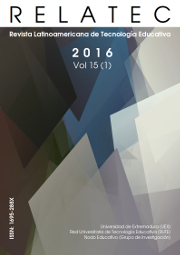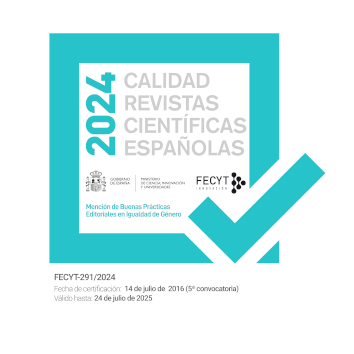Aprendizaje ubicuo: un proceso formativo en educación física en el medio natural / Ubiquitous learning: a learning process in Physical Education in the Natural Environment
DOI:
https://doi.org/10.17398/1695-288X.15.1.59Palabras clave:
Aprendizaje móvil, Tecnología educativa, Formación de docentes, TIC, Educación FísicaResumen
Este artículo presenta un proceso formativo de aprendizaje ubicuo con apoyo tecnológico, desarrollado en el área de Educación Física en el Medio Natural (EFMN). La investigación ha permitido analizar cómo repercute el aprendizaje ubicuo en la enseñanza/aprendizaje en el Grado de Educación Primaria en Educación Física, apoyándose en estudios de caso. Entre otros resultados, el aprendizaje ubicuo ha favorecido que el alumnado y el profesor hayan interactuado en el proceso desde distintos espacios y momentos, uniendo los ámbitos formales e informales, así como aportando un beneficio en los distintos elementos del currículum oficial. De esta manera, el alumnado ha incrementado su competencia digital, junto con una mejor adquisición de los contenidos de la asignatura, superando las distintas problemáticas que han emergido durante el proceso. Las conclusiones señalan que las herramientas tecnológicas han apoyado el currículum de EFMN, favoreciendo un proceso formativo ubicuo. Describimos la experiencia formativa realizada en la asignatura durante el curso 2012-2013, junto con su implementación tecnológica.
Abstract
In this paper we present a technology-supported ubiquitous learning process, developed in the area of Physical Education in the Natural Environment. The research conducted allowed us to analyze how ubiquitous learning impacted on the teaching / learning process in a university degree on Primary Education with a major in Physical Education, using a case study method. Among other findings, the research results suggest that ubiquitous learning encouraged students and teacher to interact in the learning process from different places and times, linking formal and informal settings, as well as providing a benefit in different elements of the official curriculum. In this way, students increased its digital competence and they achieved a better understanding of the contents of the subject, overcoming problems that emerged during the process. The conclusions we reached point out that technological tools supported the EFMN curriculum, causing an ubiquitous training process. In this paper, we describe the educational experience carried out in the subject during the 2012-2013 academic year, as well as the technological implementation performed.
Descargas
Referencias
Bazeley, P., & Jackson, K. (2013). Qualitative data analysis with NVivo. Thousand Oaks, California: SAGE Publications.
Burbules, N. C. (2012). Ubiquitous learning and the future of teaching. Encounters on education=Encuentros sobre educación=Recontres sur l’éducation, 13, 3-14.
Burbules, N. C. (2014). El aprendizaje ubicuo: nuevos contextos, nuevos procesos. Entramados: educación y sociedad, 1, 131-134.
Carrasco, A., Donoso, J. A., Duarte, T., Hernández, J. J., López, R., & Núñez, C. (2009, septiembre). Aprendizaje basado en proyectos versus aprendizaje basado en actividades: una experiencia de elaboración y análisis de los estados financieros. Trabajo presentado en VI Jornada de Docencia en Contabilidad (ASEPUC), Sevilla.
Castro-Lemus, N., & Gómez, I. (2016). Incorporating QR codes in Physical Education in Secondary. Retos: nuevas tendencias en educación física, deporte y recreación, 29, 114-119.
Cope, B., & Kalantzis, M. (2010). Ubiquitous learning. Urbana and Chicago: University of Illinois Press.
Denzin, N. K., & Lincoln, Y. S. (2011). The SAGE handbook of qualitative research (Fourth Edi). Thousand Oaks, Calif.: Sage.
Dewey, J. (1915). The school and society. Chicago: University of Chicago Press.
Downes, S. (2008). The future of online learning: ten years on. Retrieved February 22, 2016, from http://www.downes.ca/files/books/future2008.pdf
Flick, U. (2010). Introducción a la Investigación Cualitativa. Madrid: Morata.
García Aretio, L. (2012). Sociedad del conocimiento y educación. Madrid: Universidad Nacional de Educación a Distancia.
Grubert, J., Langlotz, T., & Grasset, R. (2011). Augmented Reality browser survey. Technical Report Retrieved February 2016, from http://www.icg.tugraz.at/publications/augmented-reality-browser-survey
Hernández, R., Fernández, C., & Baptista, M. P. (2010). Metodología de la investigacion. México D.F.: McGraw Hill.
Jorrín-Abellán, I. M., & Stake, R. E. (2009). Does ubiquitous learning call for ubiquitous forms of formal evaluation? An Evaluand Oriented Responsive Evaluation Model. Ubiquitous Learning: An International Journal, 1(3), 71–82.
Martín-Gutiérrez, J. (2011). Generic user manual for maintenance of mountain bike brakes based on augmented reality. Proceedings of the 28th International Symposium on Automation and Robotics in Construction, ISARC 2011, Seúl, Corea del Sur.
Monguillot, M., González, C., Guitert, M., & Zurita, C. (2014). Una experiencia colaborativa mediante códigos QR. Revista de Universidad y Sociedad Del Conocimiento, RUSC, 11(1), 175–191.
Mosier, B. (2014). Meeting PETE students in their world: tracking physical activity through technology. JOPERD: The Journal of Physical Education, Recreation & Dance, 85(3), 46–49.
Muñoz-Cristóbal, J. A., Prieto, L. P., Asensio-Pérez, J. I., Martínez-Monés, A., Jorrín-Abellán, I. M., & Dimitriadis, Y. (2014). Deploying learning designs across physical and web spaces: Making pervasive learning affordable for teachers. Pervasive and Mobile Computing, 14, 31–46.
Muñoz-Cristóbal, J. A. (2015). Supporting teacher ochestration of across-spaces learning situations (Tesis doctoral). Retrieved from https://uvadoc.uva.es/handle/10324/15288
Muñoz-Cristóbal, J. A., Jorrín-Abellán, I. M., Asensio-Pérez, J. I., Martínez-Monés, A., Prieto, L. P., & Dimitriadis, Y. (2015). Supporting Teacher Orchestration in Ubiquitous Learning Environments: A Study in K-12 Education. Transactions on Learning Technologies, 8(1), 83–97.
Pérez, M. M., & Pérez, R. (2012). Propuesta de unidad didáctica sobre geocaching: en busca del tesoro escondido. EmásF: revista digital de educación física, 19, 155-172.
Prat, Q., Camerino, O., & Coiduras, J. (2013). Introducción de las TIC en Educación Física. Estudio descriptivo sobre la situación actual. Apunts: Educación Física Y Deportes, 113, 37–44.
Rodríguez, E. (2015). A rede social educativa Edmodo na Educación Física como ferramenta de integración das TIC na aula Abalar. Revista galega de educación, 62, 26-29.
Specht, M., Tabuenca, B., & Ternier, S. (2013). Tendencias del aprendizaje ubicuo en el internet de las cosas. Campus virtuales, 2(2), 30–44.
Stake, R. (1998). Investigación con estudio de casos. Madrid: Morata.
Stake, R. (2005). Multiple Case Study Analysis. New York: The Guilford Press.
Valero-García, M., & Zubia, J. G. (2011). Cómo empezar fácil con PLB. Universidad de Sevilla. Escuela Técnica Superior de Ingeniería Informática.
Vázquez-Cano, E. (2015). The challenge of teacher training for using of mobile digital devices in higher education. Perspectiva Educacional, 54(1), 149-162.
Weiser, M. (1991). The Computer for the 21st Century. Scientific American, 265, 94-104.
Descargas
Publicado
Número
Sección
Licencia
Los autores/as que publiquen en esta revista aceptan las siguientes condiciones:
1. Los autores/as conservan los derechos de autor y ceden a la revista el derecho de la primera publicación, con el trabajo registrado con la licencia Creative Commons Reconocimiento-NoComercial-SinObraDerivada 4.0 International (CC BY-NC-ND), que permite a terceros utilizar lo publicado siempre que mencionen la autoría del trabajo y a la primera publicación en esta revista.
2. Los autores/as pueden realizar otros acuerdos contractuales independientes y adicionales para la distribución no exclusiva de la versión del artículo publicado en esta revista (p. ej., incluirlo en un repositorio institucional o publicarlo en un libro) siempre que indiquen claramente que el trabajo se publicó por primera vez en esta revista.
3. Se permite y recomienda a los autores/as a publicar su trabajo en Internet (por ejemplo en páginas institucionales o personales) antes y durante el proceso de revisión y publicación, ya que puede conducir a intercambios productivos y a una mayor y más rápida difusión del trabajo publicado (vea The Effect of Open Access).









